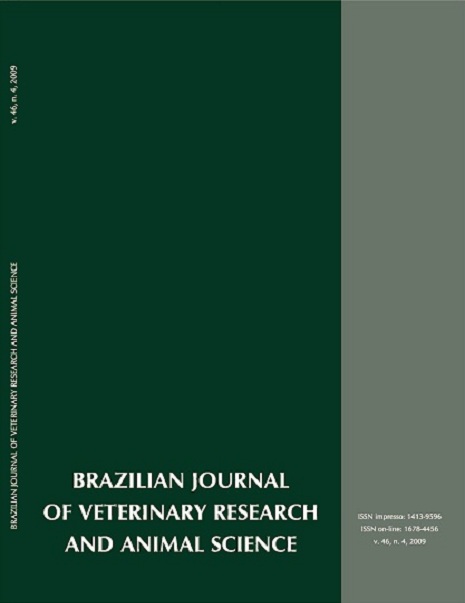Radiographics and tomographics findings of the lumbosacral junction in German Sheperd dogs: comparative study
DOI:
https://doi.org/10.11606/issn.1678-4456.bjvras.2009.26778Keywords:
Dogs, Lumbosacral junction, Radiography, TomographyAbstract
The name cauda equina syndrome defines the clinical signs that come from the sensory and or motor neural dysfunction caused by the terminal part of the spinal cord and adjacent nerve roots damages. The stenosis lumbosacral is the most frequent cause, correlating to the alterations of the soft tissues and/ or the bone tissues in the lumbosacral segment. The aim of this study was to analyze critically the real contribution of diagnostic imaging (X-Ray and CT), of the lumbosacral region of 30 German shepherd dogs. There were thirteen animals that belonged to the group (A) without clinical signs and X-Ray alterations in the lumbosacral segment; twelve animals belonged to the group (B) without clinical signs, with X-Ray alterations in the lumbosacral segment; five animals belonged to the group (C) with clinical signs and they had X-Ray alterations in the lumbosacral segment. All exams were submitted to one evaluation report. The CT examination showed being superior in the evaluation of the vertebral canal, intervertebral foramen and the articular processes, which could be evaluated with a greater number of details. It was concluded with this research that the two modalities of images complement each other, becoming important tools in the clinicalsurgical evaluation in the lumbosacral segment, helping in the diagnosis, prognostic and therapeutic to be adopted.Downloads
Download data is not yet available.
Downloads
Published
2009-08-01
Issue
Section
UNDEFINIED
License
The journal content is authorized under the Creative Commons BY-NC-SA license (summary of the license: https://
How to Cite
1.
Silva TRC da, Ghirelli C de O, Hayashi AM, Sant'ana AJ, Matera JM, Pinto ACB de CF. Radiographics and tomographics findings of the lumbosacral junction in German Sheperd dogs: comparative study. Braz. J. Vet. Res. Anim. Sci. [Internet]. 2009 Aug. 1 [cited 2024 Jul. 26];46(4):296-308. Available from: https://www.revistas.usp.br/bjvras/article/view/26778





